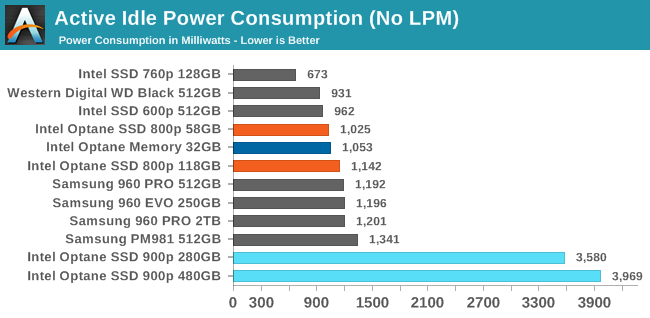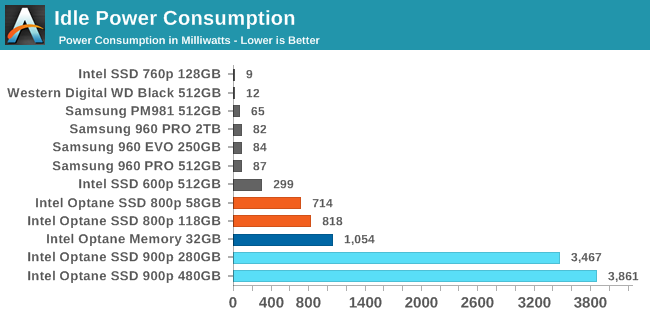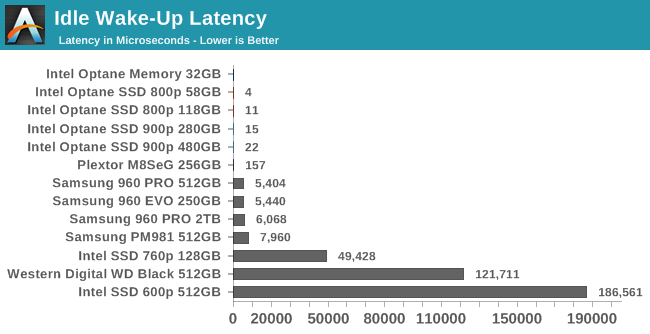The Intel Optane SSD 800p (58GB & 118GB) Review: Almost The Right Size
by Billy Tallis on March 8, 2018 5:15 PM ESTPower Management
Real-world client storage workloads leave SSDs idle most of the time, so the active power measurements presented earlier in this review only account for a small part of what determines a drive's suitability for battery-powered use. Especially under light use, the power efficiency of a SSD is determined mostly be how well it can save power when idle.
SATA SSDs are tested with SATA link power management disabled to measure their active idle power draw, and with it enabled for the deeper idle power consumption score and the idle wake-up latency test. Our testbed, like any ordinary desktop system, cannot trigger the deepest DevSleep idle state.
Idle power management for NVMe SSDs is far more complicated than for SATA SSDs. NVMe SSDs can support several different idle power states, and through the Autonomous Power State Transition (APST) feature the operating system can set a drive's policy for when to drop down to a lower power state. There is typically a tradeoff in that lower-power states take longer to enter and wake up from, so the choice about what power states to use may differ for desktop and notebooks.
We report two idle power measurements. Active idle is representative of a typical desktop, where none of the advanced PCIe link or NVMe power saving features are enabled and the drive is immediately ready to process new commands. The idle power consumption metric is measured with PCIe Active State Power Management L1.2 state enabled and NVMe APST enabled.



The Optane SSD 800p has a bit of an unusual suite of power management capabilities. Previous Optane products have not implemented any low-power sleep states, giving them quite high idle power consumption but entirely avoiding the problem of latency waking up from a sleep state. The 800p implements a single low-power sleep state, while most NVMe SSDs that have multiple power states have at least two or three idle states with progressively lower power consumption in exchange for higher latency to enter or leave the sleep state. On the other hand, the 800p has three tiers of active power levels, so devices with strict power or thermal limits can constrain the 800p when properly configured.
Unfortunately, our usual idle power testing method didn't work with the 800p, leading it to show only a modest reduction in power rather than a reduction of multiple orders of magnitude. This may be related to the fact that the Optane SSD 800p indicates that it may take over a full second to enter its idle state. This is an unusually high entry latency, and something in our system configuration is likely preventing the 800p from fully transitioning to idle. We will continue to investigate this issue. However, based on the specifications alone, it looks like the 800p could benefit from an intermediate idle state that can be accessed more quickly.
(I should mention here that the last Intel consumer SSD we reviewed, the 760p, also initially showed poor power management on our test. We were eventually able to track this down to an artifact of our test procedure, and determined that the 760p's power management was unlikely to malfunction during real-world usage. The 760p now ranks as the NVMe SSD with the lowest idle power we've measured.)










116 Comments
View All Comments
Hurr Durr - Thursday, March 8, 2018 - link
Hypetane!iter - Thursday, March 8, 2018 - link
optane = hypetanex-point = xtra-pointless
It keeps getting worse and worse instead of getting better. The next x-point iteration may slip below nand even in the few strong points of the technology.
Also, it doesn't seem that enterprise is very interested in intel's offering, seeing how they struggle to cram the product in market niches where it is xtra-pointless, I'd go on a limb and assume that's not because of love for consumers or skipping on them fat enterprise product margins.
Also, it seems that intel gave very misleading information not only in terms of performance, but also regarding the origin of the technology. The official story is its development began in 2012 as a joint venture between intel and micron.
That however is not true, x-point can be traced back to a now erased from history company named Unity Semiconductors, which was flogging the tech back in 2009 under the CMOx moniker.
Courtesy of archive.org, there is still some trace of that, along with several PDFs explaining the operational principle of what intel has been highly secretive about:
https://web.archive.org/web/20120205085357/http://...
All in all, the secrecy might have to do with intel's inability to deliver on the highly ambitious expectations of the actual designers of the tech. It is nowhere near the 200% better than nand density, in fact it seems at the current manufacturing node it won't be possible to make more than 256 gb in m2 form factor, which is 8 times less than mlc nand or 24 times less than what was projected in 2009. Performance is not all that stellar too, a tad lower than what slc was capable at back in 2012, thank the gods nobody makes slc anymore, so there's a ray of sun to make xtra-pointless hypetane look good on paper.
chrnochime - Thursday, March 8, 2018 - link
Rambus renamed it to ReRAM according to this article in 2015, so it would seem the tech lived on through Rambus after the aquisition of Unity Semi.https://www.eetimes.com/document.asp?doc_id=132552...
But I'm not sure if it's the exact same tech as Intel's.
iter - Thursday, March 8, 2018 - link
Check the PDFs, what little intel posted about it is all there. They may have licensed the tech from rambus. It is not like rambus does anything other than patent milking anyway.iter - Thursday, March 8, 2018 - link
"Coincidentally", rambus bought unity in 2012, exactly when intel allegedly started developing...MDD1963 - Friday, March 23, 2018 - link
Not everyone remembers a few sticks of RAMBUS RDIMMS for some Pentium 3 boards costing $500-$600 a stick back in '99-'00....; and being outperformed by DDR. Nice job, RAMBUS!tommo1982 - Thursday, March 8, 2018 - link
Am I reading it right? Was Cross-point memory supposed to be cheaper than NAND?WinterCharm - Thursday, March 8, 2018 - link
Yes. But I guess we won't see that for a while.Latency and power consumption are great... but speed and capacity leave a lot to be desired. When MacBook Pros have NVME drives capable of 3.2 GB/s (yes gigabytes) at a 2TB capacity... Optane is far behind.
There are some advantages, but I expect that Intel will need to do a lot more work before these are cheaper, faster, and have higher capacity.
Reflex - Friday, March 9, 2018 - link
That said, latency is what users notice. Max speed is a rarely encountered scenario in most user workloads.iter - Saturday, March 10, 2018 - link
No human notices microseconds. Delay becomes noticeable at about 10-20 msec, depending on the individual's reflexes, becomes annoying at about 50 msecs, and becomes detrimental at 200+.10 mseconds is 10000 microseconds. Hypetane improves things in the double digit microseconds range. Humans cannot notice that, not today, not in a million years.